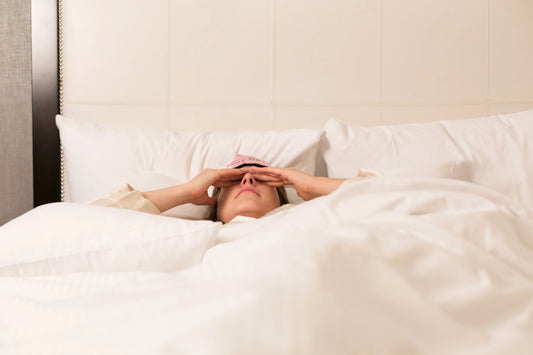Chances are you have a specific way that you tend to sleep every night. Whether you are a side sleeper, a back sleeper, or log sleeper, your sleep position could say a lot about you, or nothing at all, depending on whom you ask.
Sleeping Positions: Do They Really Matter?
Our sleeping positions go beyond simply lying on our back, front and sides. Some people sleep best on their sides, while others will favor stretching out across the bed. And many factors are entirely external, like how comfortable your mattress is, if you are using the right pillow, and how your bed partner sleeps.
Your body language can reveal a lot about your personality and your thoughts. But you’ll be surprised to know that your body is communicating even when you’re asleep. So even though there isn’t a sleep position personality test, we are breaking down the six most common sleep positions, the often associated traits, and what research really has to say about it.
Researchers, psychologists and sleep scientists alike have been studying the most common sleep patterns to get an inside scoop about what they mean. What you may not know is that when it comes to catching those premium hours of rest, the position that you sleep in may be the reason for your recent lack of sleep. Whether you are on your side, on your back, or somewhere in between, sleeping positions vary as much as the sleeper.

Sleep Position: The Freefaller
You lie on your stomach with your hands up by your pillow and your head turned to the side, like a skydiver. Also known as the prone position, this position seems to be more common with Gen Xers and millennials, according to recent research by the Better Sleep Council (BSC).
What this says about you
Personality traits: Some say freefallers don’t take criticism well and tend to be brash, bold, and outspoken in nature. They also do their best to avoid extreme situations.
Tip: If you have back problems, taking pressure off a sore spine while you sleep may feel better. However, use only a thin pillow when sleeping in this position, as too high of a stack can place undue strain on the neck and cause stiffness in the morning.
Sleep Position: The Fetal Position
You lie on your side with your knees bent towards your chest, curled up like a baby. Many people fall asleep in a fetal position because it offers them a sense of safety as they doze off. This is the most common sleeping position among Americans (47%)—and it’s more common with women than men.
What this says about you
Personality traits: Sensitive at heart, people who report sleeping in the fetal position may show traits of shyness and introversion. Fetal sleepers tend to be quite personable, even if they come off as shy upon first meeting people.
Tip: This is one of the most natural ways to sleep and may be comfortable for those who have stomach issues and acid reflux.
Sleep Position: The Yearner
You lie on your side with both arms stretched out in front of you. Boomers are more likely to sleep this way than millennials and Gen Xers.
What this says about you
Personality traits: Open-minded, complex, and cynical. Some sources say yearners can be slow in making decisions but are resolute once their mind’s made up.
Tip: If you have a hard time finding a comfortable position, this one may be a good option. The yearner position allows your spine and joints to settle into their natural line. Plus a pillow designed specifically for side sleeping will be a benefit.
Sleep Position: The Log
The log position is a side-sleeping position—but unlike the fetal position (where the person is curled up like a ball), in this position, you sleep with your legs extended straight with arms in place. Only about 6% of Americans report sleeping like a log.
What this says about you
Personality traits: Easy going, social, and trusting of others. Log sleepers are also more likely to consider themselves to be healthy.
Tip: A pillow designed just for side sleepers may be a good option for optimum comfort.
Sleep Position: The Soldier
You lie on your back with both arms down by your sides. It’s another not-so-popular position with only 11% of Americans preferring to sleep this way, although sleep lab studies show that most people (over 62%) actually start out laying on their backs, before ending up in other positions.
What this says about you
Personality traits: Quiet and reserved. Soldiers may hold both themselves and other people to high standards. They’re also huge fans of structure and routine and tend to be on the more serious side.
Tip: For people who have a hard time relaxing to fall asleep, using this position and yoga breathing techniques may help with occasional or chronic insomnia.
Sleep Position: The Starfish
You lie on your back with both arms up by your pillow. Men are more likely to sleep in the Starfish position than women.
What this says about you
Personality traits: These types of sleepers are more positive and helpful. They have an easy-going, positive outlook, much like side sleepers. They will do anything to help friends and family, and are extremely loyal to those that they hold dear to them
Tip: If you spend a lot of time sitting over a computer, spreading out while you sleep may help your muscles relax.
If you sleep in different positions rather than one, some say that may be a sign that you have a multifaceted personality which has hidden depths not even you yourself fully comprehend yet. The truth is, we change positions in our sleep as much as ten to 30 times a night!

So What Is The Best Position For Sleeping According to Science?
Research says that side sleeping is considered a healthy position for most people, especially snorers, those with mild sleep apnea, and neck and back pain. Positioning yourself on your side (or even your stomach) can help keep your airways open and reduce snoring.
And Which Sleep Position Is Considered the Worst?
On the other hand, sleeping on your back can affect the flow of oxygen to the body, which can aggravate snoring and lead to more frequent episodes of apnea. If sleeping on your back is a comfortable position for you, research suggests placing a pillow behind your knees to help support your spine and reduce pressure that could lead to back pain.
Stomach sleeping can help reduce snoring and sleep apnea, so it may be a smart choice for people with mild versions of these conditions who can’t get comfortable sleeping on their sides. But stomach sleeping is a recipe for unnecessary neck pain and strain. Sleeping prone makes it difficult to maintain a neutral spine, which can be hard on your back and neck.
Which is the best direction to sleep?
Sleeping on your left side relieves pressure from your liver and allows blood to flow more freely, making it a better option than others. Sleeping on your right side could also worsen instances of heartburn and put strain on other internal organs. If you are pregnant, sleeping on your left side is important because it improves circulation to your baby and also relieves pressure from the liver pressing on the uterus.
Well, hopefully you’ve learned a little more about yourself – or had a good laugh. Remember that no matter what sleep position you choose, establishing good sleep habits and setting up your bedroom for sleep will help you get the quality zzz’s you are seeking.
Before you go to bed tonight, check out the position you find yourself in right before you fall asleep. Does your position and personality type match up?





